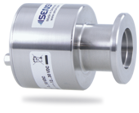WHAT IS A HEAT-LOSS VACUUM GAUGE?
A heat-loss vacuum gauge or sensor is a device for measuring vacuum gas pressure by measurement of the pressure dependent thermal conductivity from a heated filament. The heat-loss gauge was first described by Marcello S. Pirani in 1906 and is commonly referred to as the Pirani gauge.
The heat-loss sensor can be made of a thin suspended wire surrounded by the vacuum gas pressure to measure. Improved performance of the heat-loss gauge has been achieved by use of MEMS (microelectromechanical systems) sensor design, where the resistive sensor filament is deposited on a suspended fixed diaphragm surrounded by the vacuum gas pressure to measure.
The heat-loss vacuum gauge has the advantage of covering a wide dynamic measurement range. The recently developed SmartPirani™ technology from Sens4 established in 2019 sets new performance standards for the heat-loss Pirani gauge by extending the measurement range of the SmartPirani™ heat-loss transducer down to 1.0E-6 mbar.
For more information about the Sens4 SmartPirani™ visit the SmartPirani™ transducer product page.
Read also: What is the working principle of the Pirani gauge?
Next generation heat-loss SmartPirani™ vacuum transducer from Sens4
■ Record-breaking performance
■ 1E-6 to 1000 mbar range
■ Programmable output
■ Digital interface
> For more information
Other related pressure measurement topics:
- What is absolute pressure?
- What is differential pressure?
- What is barometric pressure?
- Pressure measurement explained




